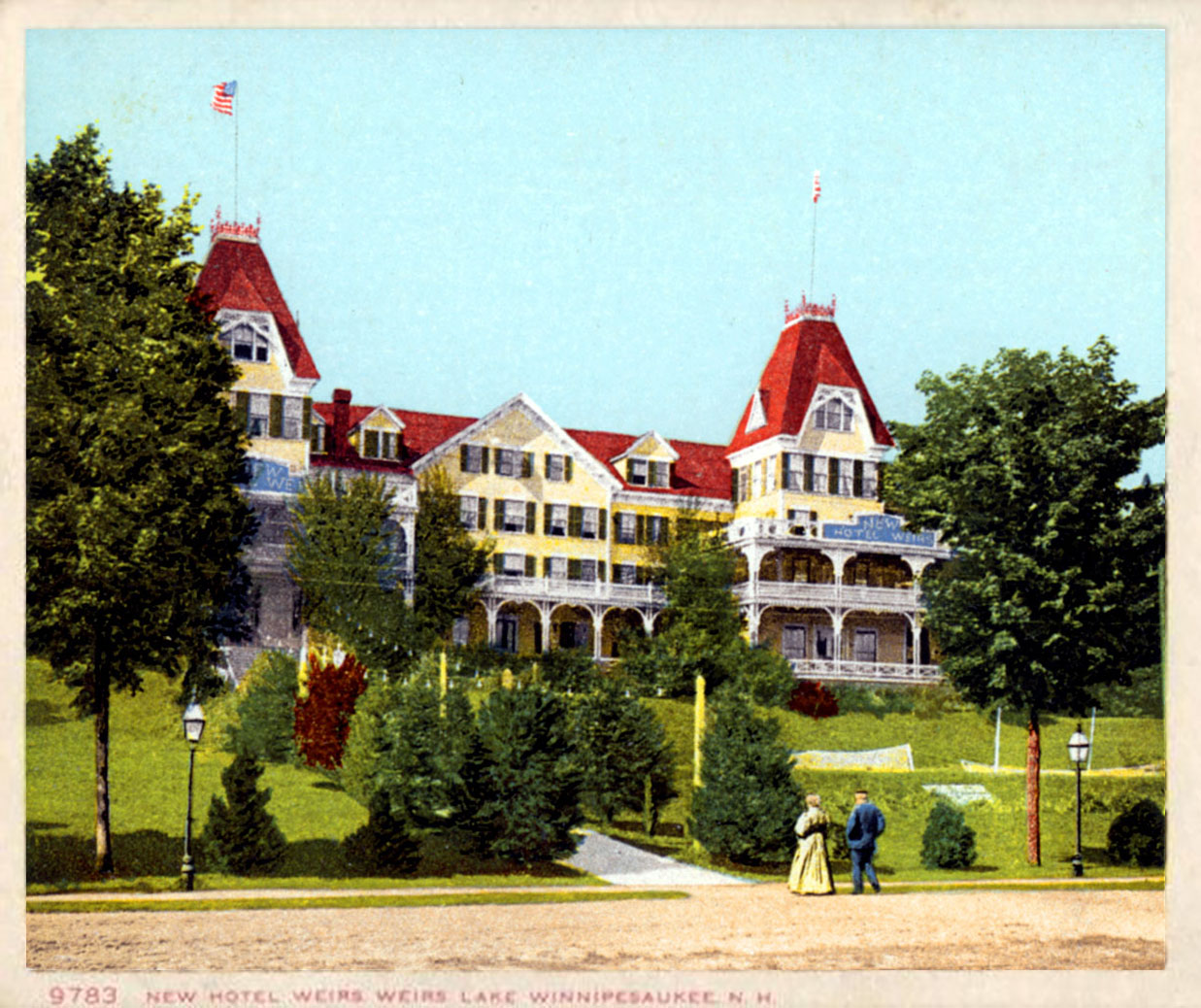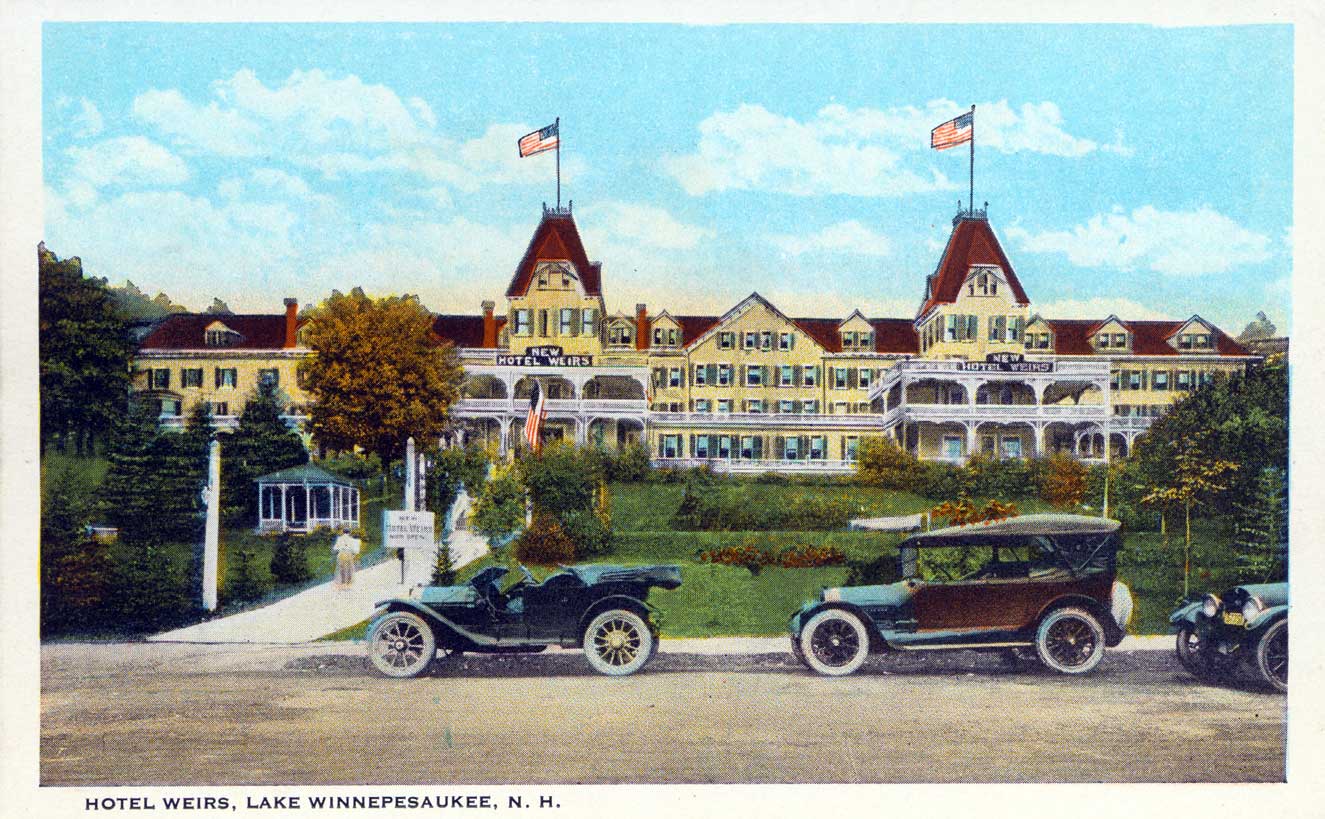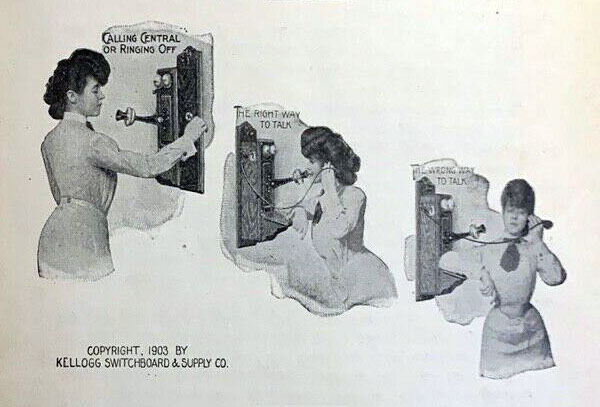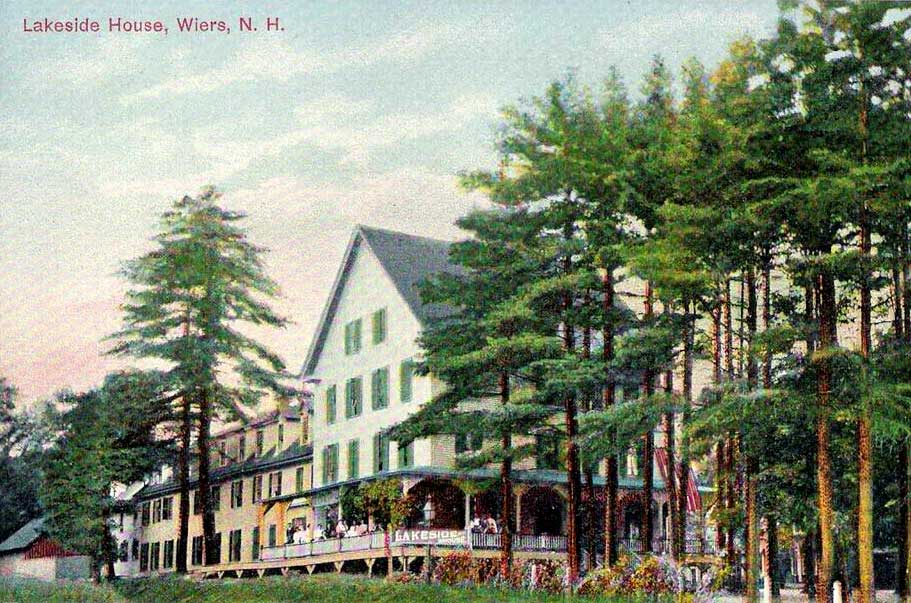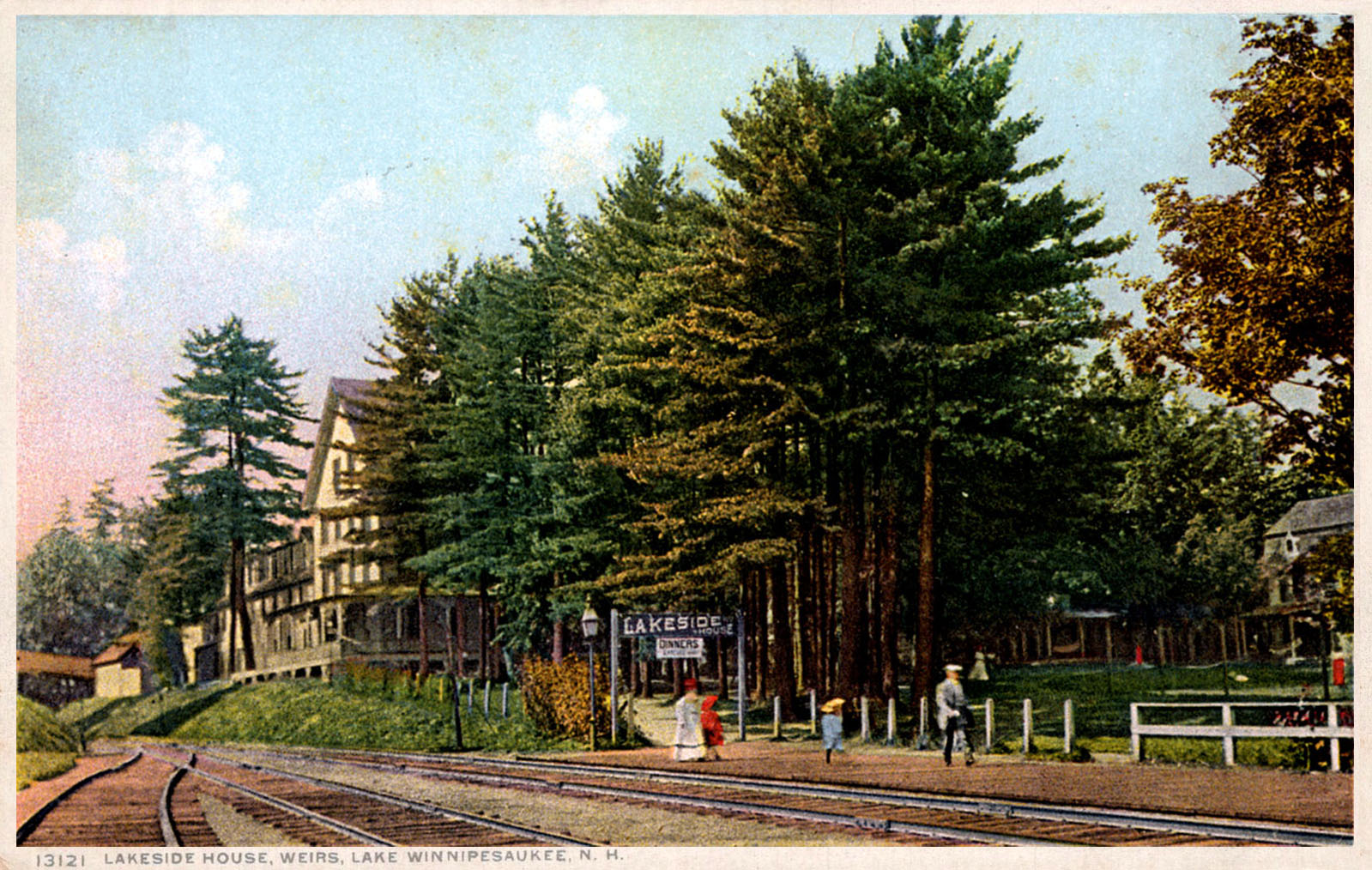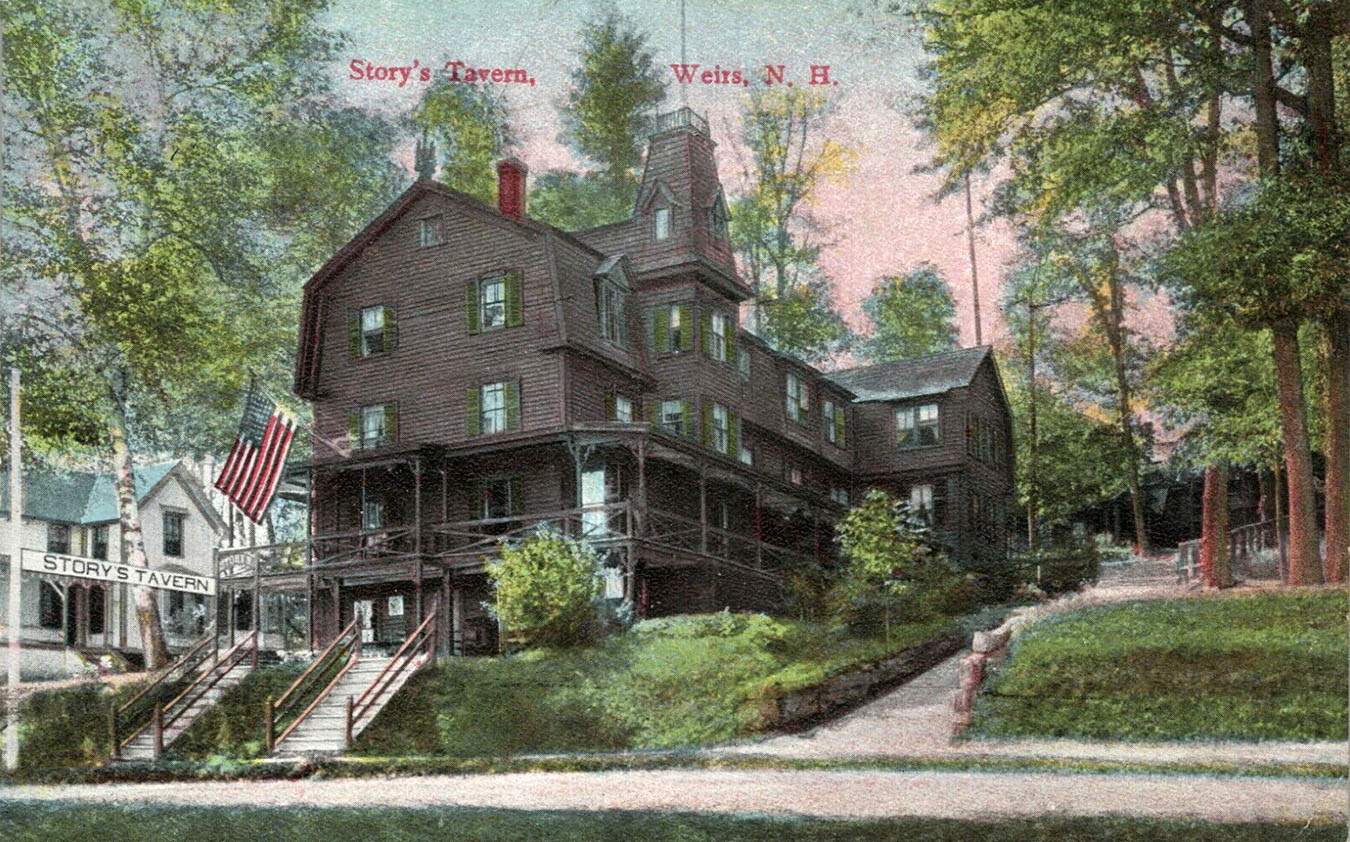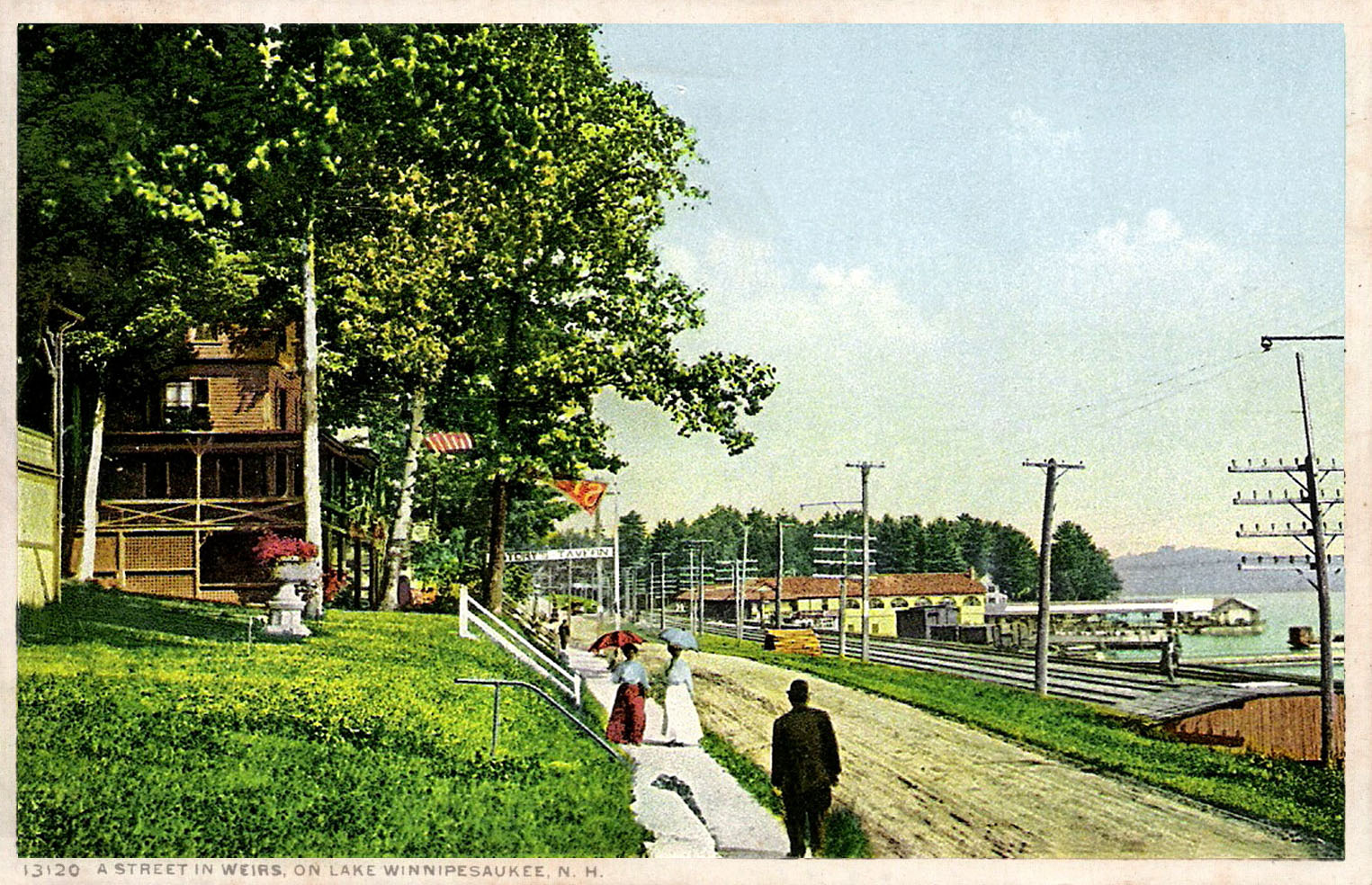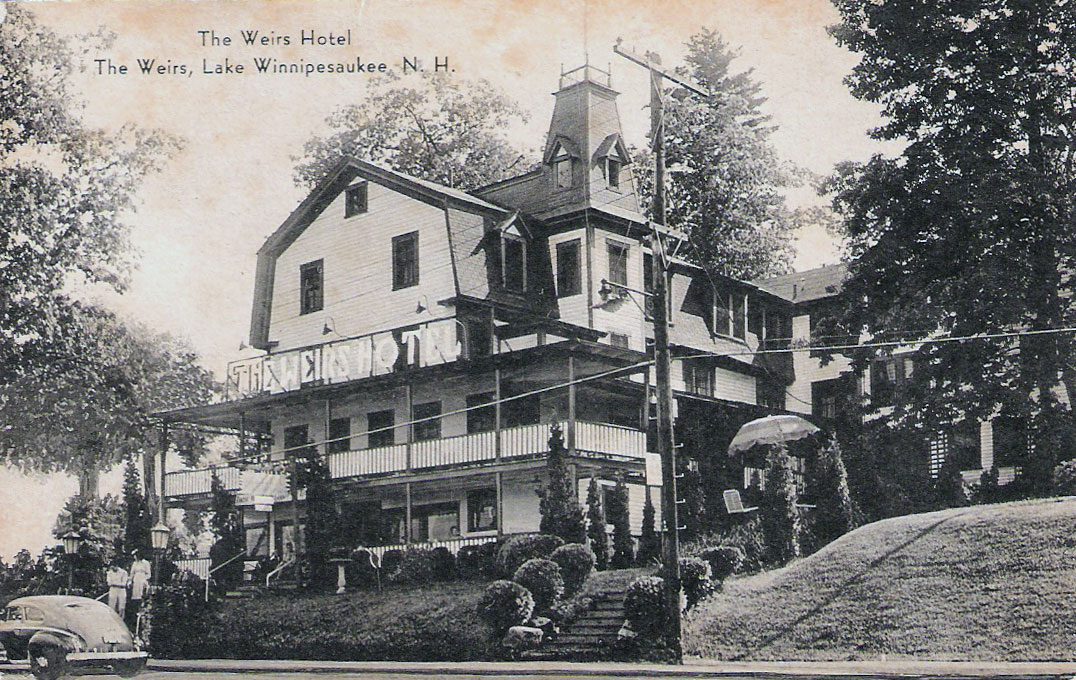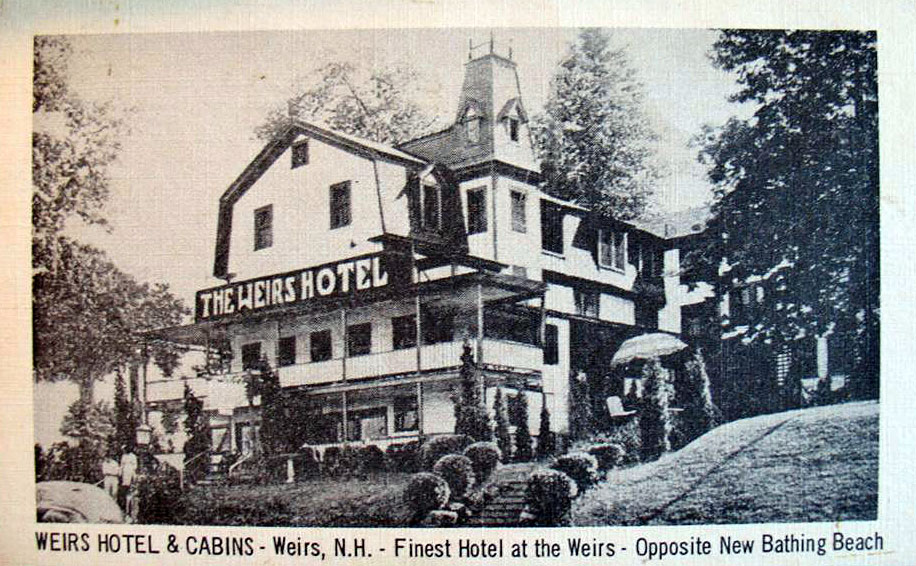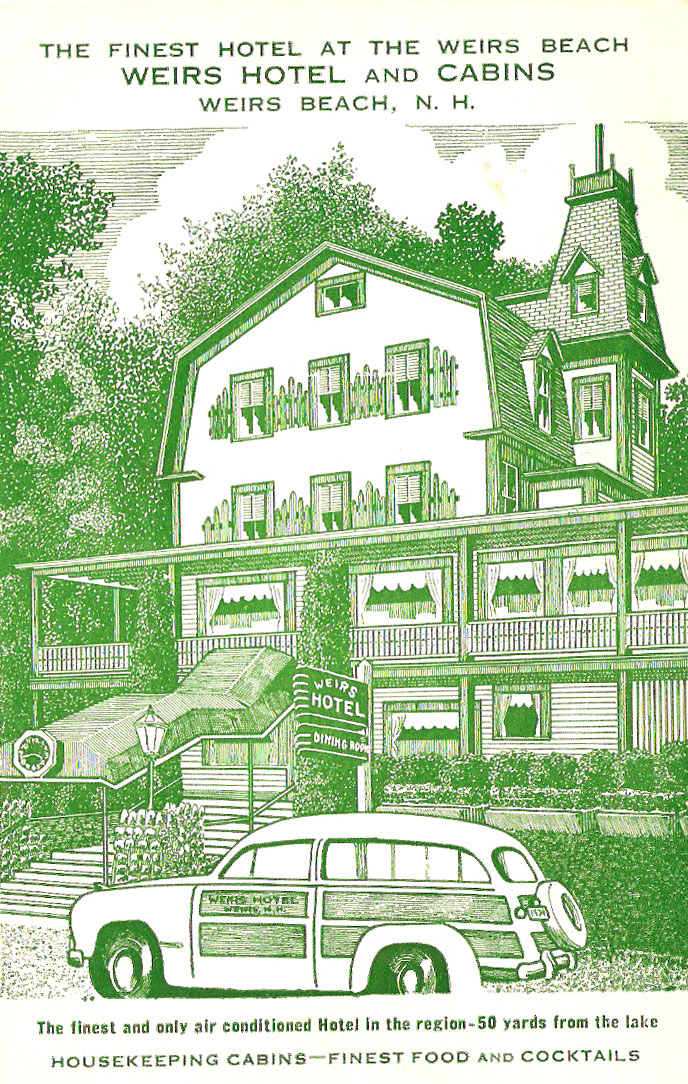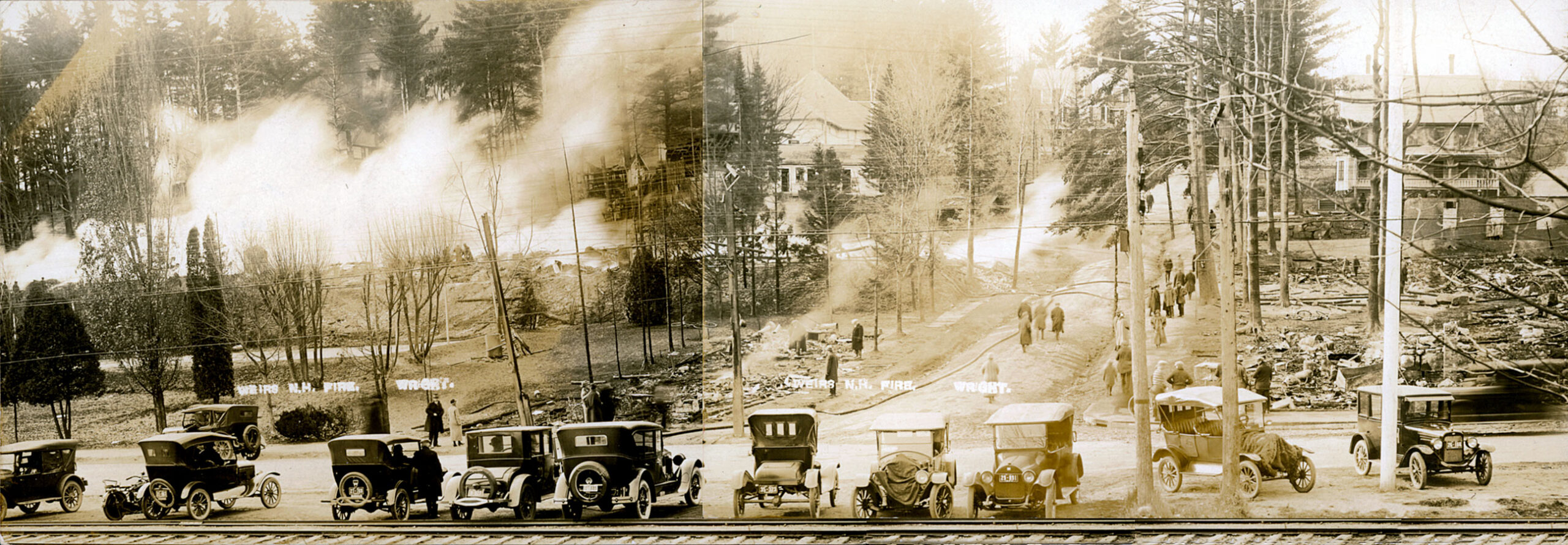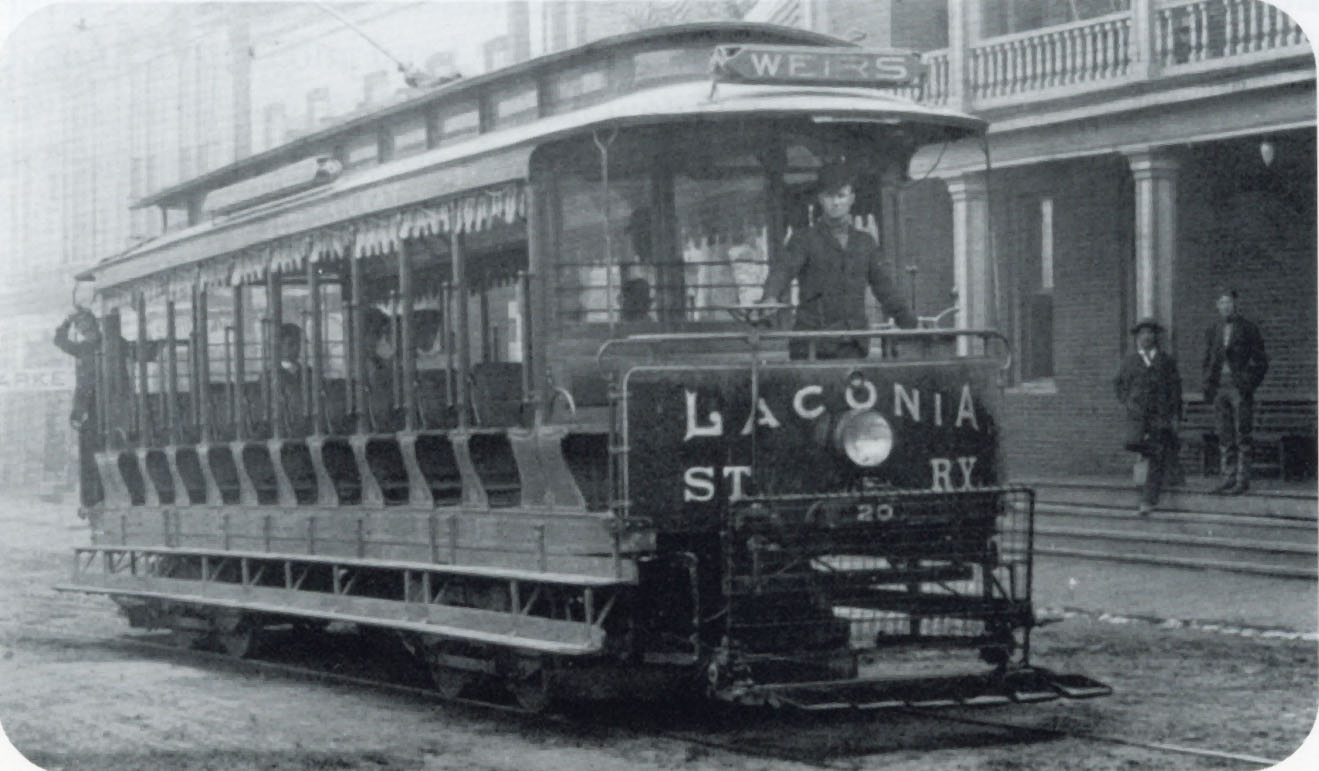Golden Era
When was the Golden Era of Weirs Beach?
The New Hotel Weirs
The Golden Era of Weirs Beach did not coincide with the similarly-named “Gilded Age” in the United States. In the US, the Gilded Age ran from 1878-1895, between the Reconstruction Era (1865-1877) and the Progressive Era (1896-1916). However, the Gilded Age did coincide with the development of Weirs Beach from a minor railroad stop into a major tourist destination.
“The four story yellow edifice was set back from the road on a terrace. Its spacious lawn was studded with trees, sculptured hedges and flower beds. Verandas furnished with white wicker furniture surrounded the first two floors. Its red roof, with American flags flying from its two turrets, gave a patriotic touch. The cozy gazebo, to the left of the entrance, lent an accent of welcome. It was a tranquil scene of affluence, streched out in all its dignity.”- Betty Hoey Leahy, who visited in the early 1920’s
Guest rooms offered “perfect sanitary arrangements”, were “fully equipped with electrical appliances”, and were “connected by telephone and telegraph…to all points”. The fine dining room’s cuisine was “excellent and up-to-date”; the water was “pure..coming directly from mountain springs”. For relaxation, guests could perambulate on the hotel’s spacious verandas, with daytime views of “unsurpassed magnificence”; in the evening the verandas were “brilliantly illuminated by hundreds of electric lights”. For entertainment, the hotel featured a “fine billiard room”, and in the music room, an “excellent orchestra” furnished “daily concerts”.
When first built in 1880 (from parts of the disassembled Diamond Island House hauled over the ice), the sign over the front door of the Hotel read “Hotel Weirs”. Even when called Hotel Sanborn in 1893, the sign was still there. In the late 1890’s, after considerable expansion, the word “New” was added both to the sign(s) over the front door(s), as well as to the name.
The Hotel was expanded in 3 phases. The left turret was the original Hotel. In 1896, the central section between the two turrets was added. In 1899, the right turret, and the rooms to the right of the right turret, were added all at the same time. In the winter of 1905-1906, the rooms to the left of the left turret were added, completing the Hotel.
For an extensive description and analysis of the architecture of the New Hotel Weirs, including other notable hotels of the Golden Era located elsewhere in New Hampshire, click here.
Ownership/management of the New Hotel Weirs changed frequently over the years:
W.H. Sanborn, 1880-1892
Charles E. Sleeper, 1893-1894
Dr. J. Alonzo Greene, 1895 -1901
Merritt & Brown 1902
Dr. J. Alonzo Greene 1903-1904
E.C. Hibbard, 1905-1907
Drs. F.A. & J.A. Greene 1908
Unknown 1909
J.G. Venetos, 1910
Dr. J. Alonzo Greene 1911 (w John J. Leahy as manager)
Lucas & Lancaster, 1912-1913
Lancaster & Lane 1914-1921
Frank H. Greene/Lancaster & Lane Hotel Co., late 1922 -1924
During its 44 years of existence, the New Hotel Weirs was owned for the longest period of time by Dr. J. Alonzo Greene. It was under his ownership that the hotel was greatly expanded to become the grandest hotel in Weirs Beach. Dr. Greene was a fascinating character who served as Mayor of Laconia from 1901-1903. For a biography of Dr. Greene, click here.
So popular was the Hotel, it was the main focus of numerous postcards from the time. In fact, no other subject was deemed as noteworthy, judging from the numerous views of the Hotel from every conceivable angle. For a grand tour of this golden age, click below to see an extensive gallery of colorful New Hotel Weirs postcards, brochures, and souvenirs.
The images have been placed roughly in chronological order, beginning in the late 1890’s and continuing through the 1910’s. To put them in chronological order the webmaster has used obvious clues. The far left wing of the hotel was the last part of the hotel to be expanded when it was extended to New Hampshire Avenue. In some of the postcards, one can see the roof of the left wing to be in a different color from the rest of the Hotel roof. Logically, images with telephone poles and wires came after those images where they are lacking (or perhaps, they were not deftly retouched by artists to remove the unsightly poles, like other postcards were).
Click here for the entire New Hotel Weirs Postcard Gallery.
Modern Utilities
The New Hotel Weirs’ elegant standard of service would not have been possible without modern utilities, which came to town as follows:
In July, 1919, the Central New Hampshire Telephone Company was formed to merge the separate telephone systems of the Citizens Telephone and the Winnipesaukee Telephone companies into one system, eliminating duplicate lines and phones. The amusing graphic above, on the right and wrong way to talk on the phone, was in the 1905 Citizens Telephone Company directory. Because of the limited capacity of the 1905 system, callers were urged to limit their calls to five minutes. As seen in the left image of the graphic, callers first had to turn a crank to reach the central operator.
Phone boxes with magneto cranks lasted until September 19, 1925. The Laconia Democrat reported that on that date, the telephone company “did away with the crank-turning system” and “connected up the hook-raising method of getting central.” The new system used battery switches, but still required operator assistance to complete calls. Such systems were still used in many small towns until the mid-1950s, when rotary, self-dial phones became nearly universal. In Laconia, it was not until March 29, 1959, that the entire local phone system changed over from operator assistance to rotary dial. In the early 1970s, touch-tone phone service was introduced. Rotary dial phones became obsolete about 20 years later.
The Laconia Electric Light Company began Weirs Beach service in 1884. In August, 1926, the Laconia Gas & Electric Company joined with 3 utility companies from Manchester, Nashua and Keene to form PSNH (Public Service of New Hampshire).
The Laconia and Lake Village Waterworks began Weirs Beach service in 1885. On December 31, 1955, the City of Laconia took over the Laconia Waterworks, and on January 4, 1956, purchased the Weirs Water Company from George W. Tarlson.
During the summer of 1971, a new kind of utility, cable television service, reached Weirs Beach, when Community TV wired up the village. In the late 1990s, high speed, broadband internet was introduced as an accessory service to the cable TV lineup. In 1998, Community TV was sold to MetroCast Cablevision. In 2014, Metrocast transitioned from analog tv delivery to an all-digital channel lineup. In 2018, Metrocast was sold to Atlantic Broadband. In 2022, Atlantic Broadband was renamed Breezeline. Also in 2022, Comcast became a 2nd, alternate provider of cable TV and high speed internet services to Weirs Beach.
Other Grand Hotels
The New Hotel Weirs was not the only large hotel in Weirs Beach at this time, although it was certainly the grandest and best known. Just across the way stood the imposing, 4-story Lakeside House, with 118 rooms. And further down Lakeside Avenue, even the more compact Story’s Tavern still offered about 70 rooms. Other notable hotels of the time included the Winnecoette, the Endicott, the Aquedoktan, and the Lakeview.
Of all the hotels mentioned, only the Lakeview is still in the business of accommodating travelers today. The Lakeside House is now a restaurant. The New Hotel Weirs (1924), Winnecoette (1989), and Aquedoktan (2010) all burned down. The Endicott is long gone, either burned or taken down in the late 1930s.
The Lakeside House
The Lakeside House became the Lakeside Hotel in the 1940’s, and then the Winnipesaukee Marketplace in 1986, when the 1890 and 1899 additions behind the original, 1880 4-story central building were torn down to make way for “Fanueil Hall North” and a small parking lot. The concept of an outdoor market, anchored by a fleet of pushcarts, surrounding a central food court, did not work out. Purchased by the Ames family in 1991, the building housed on its first floor the Patio Garden Restaurant, Stageview Subshop, and J.B. Scoops Ice Cream until 2020, when it was sold to new owners. There remain about 20 vacant rooms in the upper 3 stories of the building.
For more colorful images and extensive information about the Lakeside House, click here to see the entire Lakeside House Gallery.
Story’s Tavern
Built around 1886, Story’s Tavern changed its name many times over the years, first becoming Story’s Tavern instead of Story’s Hotel in the late 1890’s, then taking on the name of Cawley’s, after owner Alice Cawley, in the early 1920s, and finally taking on the name of the “Weirs Hotel” in the late 1940’s. By the 1980’s it had fallen into disrepair and was called “That Olde House”. The unoccupied building burned down on September 27, 1991. The location is now the Beachview parking lot.
For more colorful images of Story’s Tavern, Cawley’s, and the Weirs Hotel, click here to see the entire Story’s Tavern Gallery.
The Weirs Hotel
Perhaps to capitalize on the enduring fame of the New Hotel Weirs, Story’s Tavern was renamed the “Weirs Hotel and Cabins” in the 1940’s. More pictures and info on the Weirs Hotel can be found in the Story’s Tavern Gallery. The cabins were located directly behind the hotel; they did not burn down in 1991 and still exist.
The Weirs Hotel postcards above and below use the same photo. However, the later, 1951 postcard below was retouched to remove the telephone pole and utility wire, and to make the name of the hotel on the sign readible. However, the postcard artist didn’t bother to remove the shadow of the telephone pole, which is still visible on the lawn.
The End of the Golden Era
The end of the Golden Era at Weirs Beach came swiftly. On November 9, 1924, a great fire destroyed the New Hotel Weirs, as well as numerous other Weirs Beach structures. In 1925, the Laconia Street Railway, which for years had brought a steady stream of customers to Weirs Beach from the burgeoning nearby “City on the Lakes”, ceased operations. And in 1929, before the grand hotel could be rebuilt, the stock market collapsed, bringing on the Great Depression. Weirs Beach was never the same again.
In the early 1930’s businessman Bob Wagner built the Half Moon Tea Room – restaurant, snack bar, bowling alley, and cabins – on the spot of the former Hotel. The modern era of Weirs Beach had begun.











